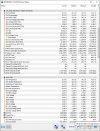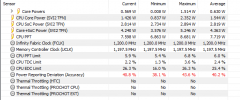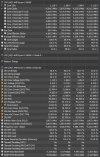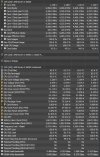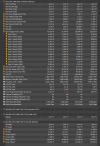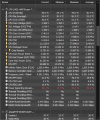I'm seeing 25-30% overreporting on my Asus X470-i. I've documented it here, and an MSI owner said he had the same issue, but was able to flash back to an older BIOS. I've tried everything that I know of, and reported it to Asus and AMD a couple times, it's tossed out immediately though.
I'm on BIOS release 4204 AGESA V2 PI 1.2.0.0, which was installed with a CMOS deep reset. Current CBR20 multicore scores are 7588 (PBO off), and 8456 (PBO on). I should be seeing closer to 8400 with PBO off and somewhere in the upper 8K range with it on. CBR20 / Ryzen Master Compared to other...

www.overclock.net
I'm on the same board as Yenic (Asus X470-i), although I have a 5800X instead of a 5900X. I can confirm that the PRD is at 120-125% and can also confirm that these boards don't have any way to adjust the full scale current.
Since Asus isn't likely to fix this, I've got to figure out how to work around it ---
So, the question is, where is the discrepancy? Based on how my board behaves in Ryzen master, it seems as though the current (I) is what is actually being over-reported... and PPT (total power in Watts) is only wrong because it is using the incorrect current in the I*E=W equation.
In the image below (current values) 95.005A/1.197 = 79.367A actually consumed, thus 79.367A * 1.194V = 94.765W actual, instead of the reported 113.075W? Is this correct?
OR is the CPU actually drawing 95A, and ONLY the PPT reporting is skewed? (If this is the case there are other issues with this board and Ryzen 5000 because it is ALWAYS TDC limited (never exceeds 95A in any situation).
In the first scenario (TDC/EDC are the "wrong" value and PPT is also wrong, but only because it was given bad amperage numbers for the power formula to work with) I should increase ALL PBO limits by 20% -- PPT 170, TDC 114, EDC 168.
In the second scenario (TDC/EDC are accurately reported, PPT is the "wrong" value) I would increase ONLY PPT to 170 -- and this problem wouldn't affect me at all because my mobo's VRM is such hot garbage that it is reporting thermal issues 100% of the time even though it is only 60C.
I suppose there is a third scenario, where the PRD would be accurate if my board weren't "lying" about the VRM being ready to explode at any second and artificially limiting itself to 95A.
A bit of a wall of text but can someone who understands this better chime in for me please? I had to install windows just to run these diagnostics and I'd like to get my computer back to working normally.
Defo my last Asus board for sure.
EDIT: I ended up leaving PPT and EDC at 142W and 140A, respectively, and bumping TDC up to 105A. At that point I'm thermally limited anyway (85C after a Cinebench r23 run). With my -20 Curve Optimizer that's got me boosting to 4.5 all core -- not good but I'll take it to call this one done.
I just need to make sure the cores are all stable single threaded. This processor ended up being such a waste of $500. I wish I hadn't gotten it. Asus really dropped the ball on M/B support to the point it's unusable. I can't even get the 15300 r23 run I should get stock with no PBO and no OC.
